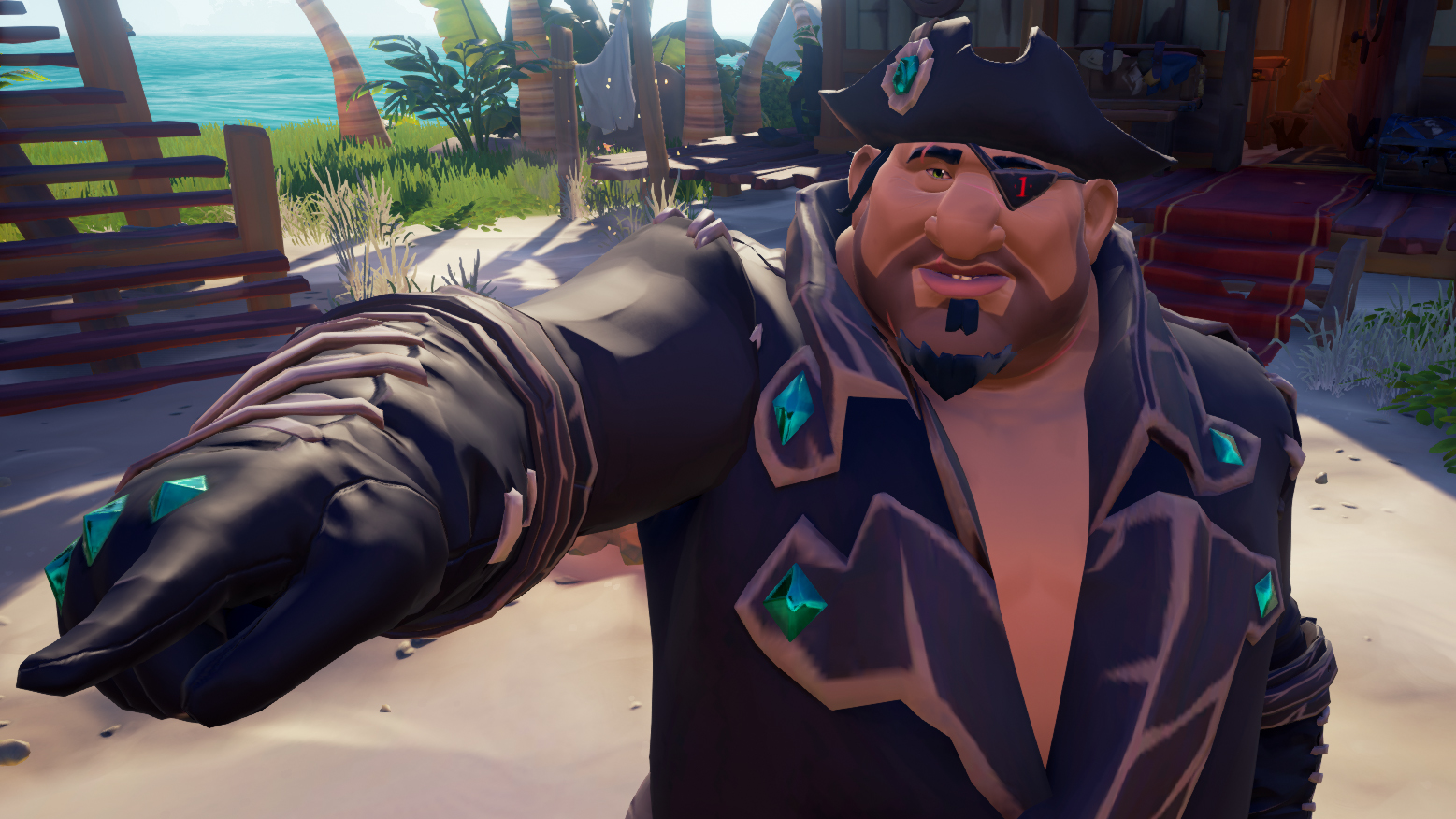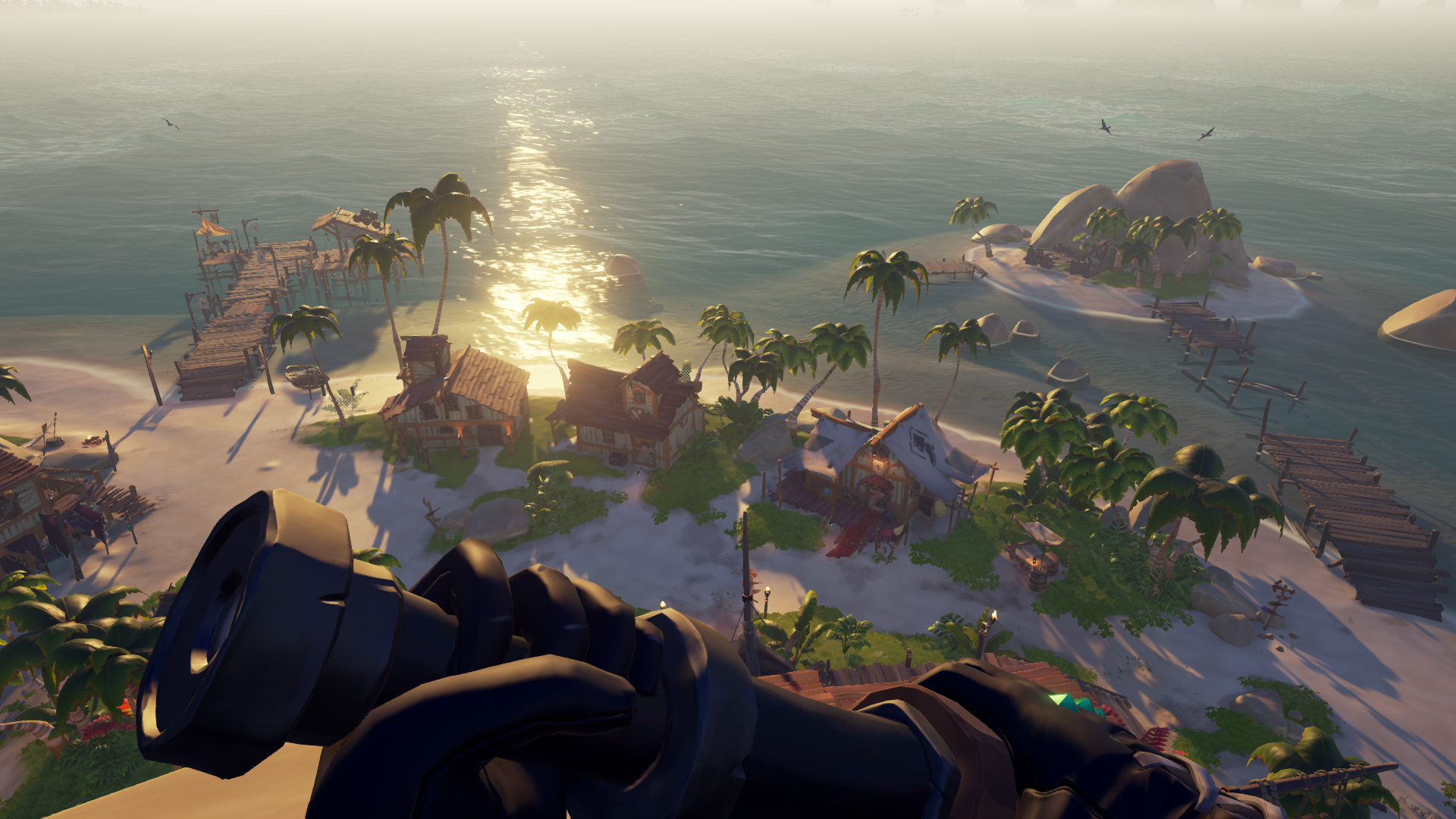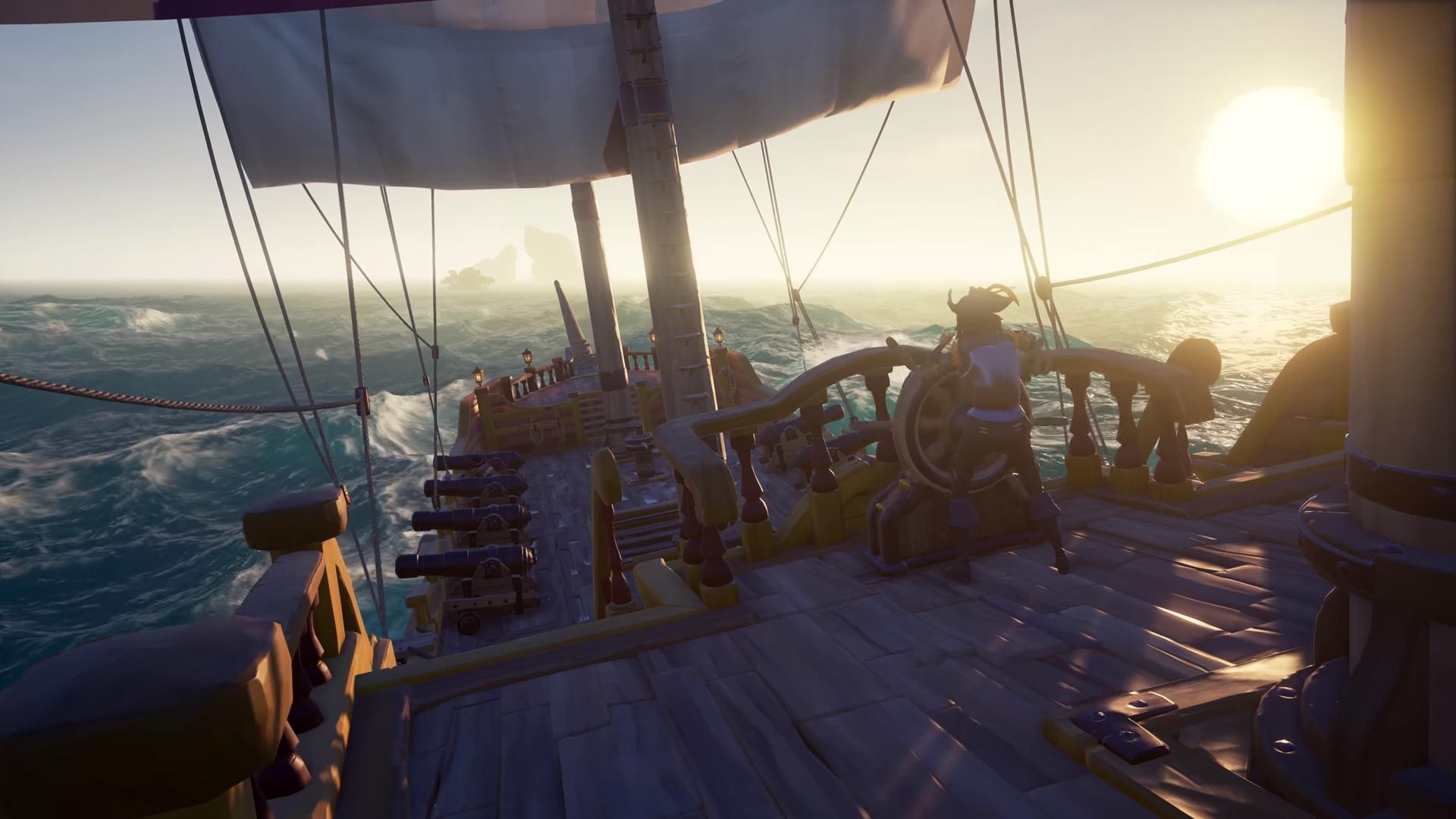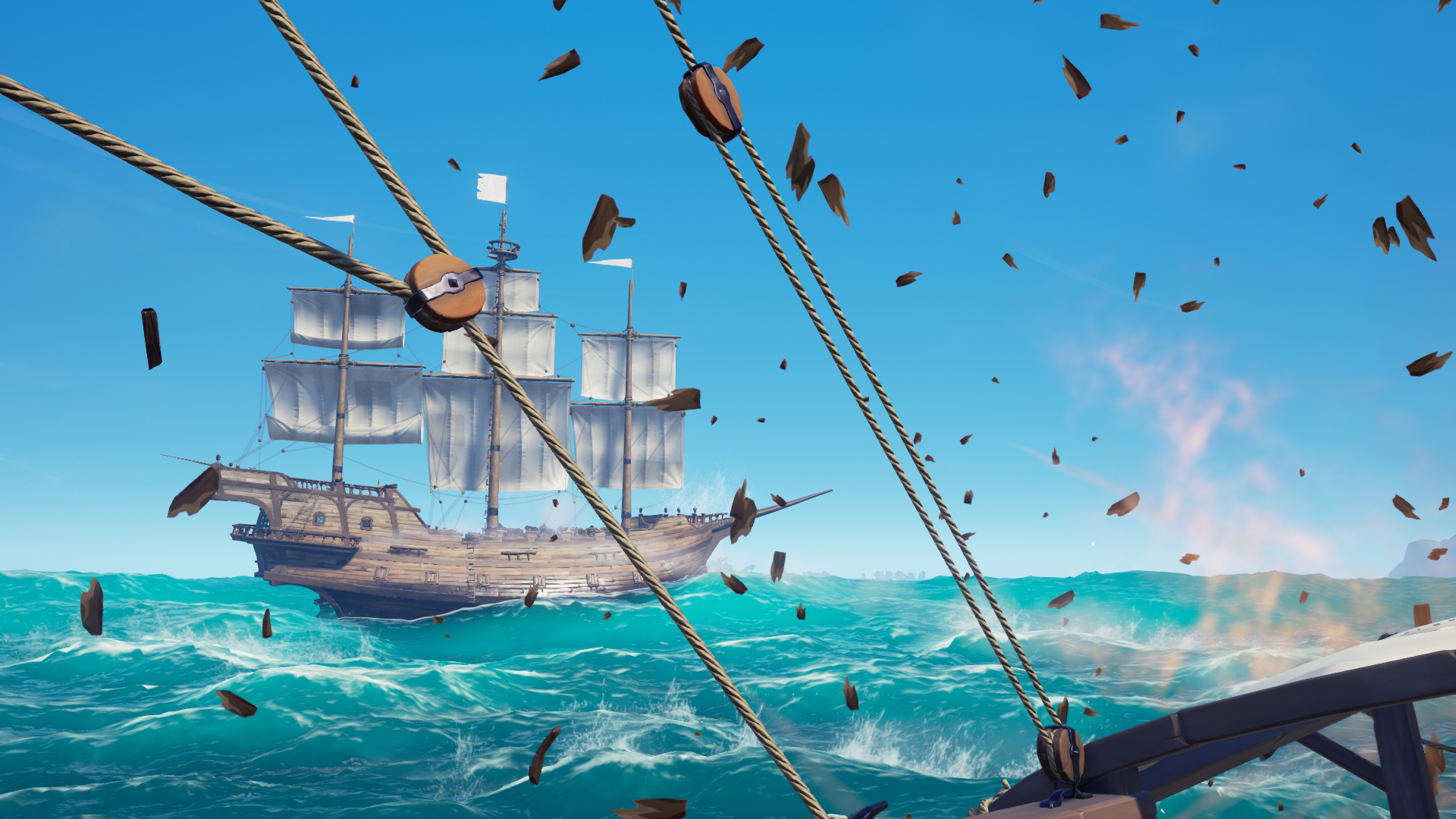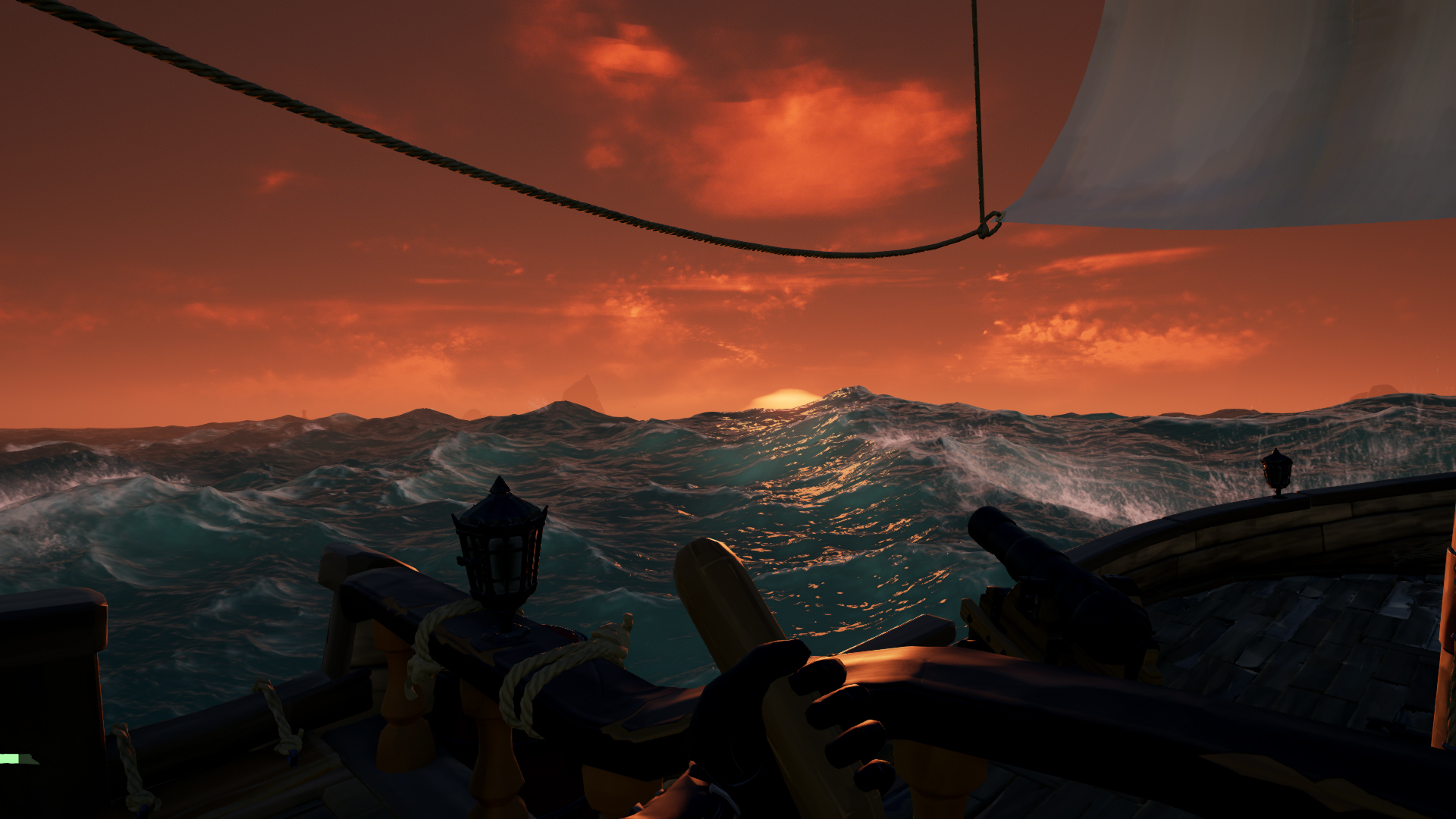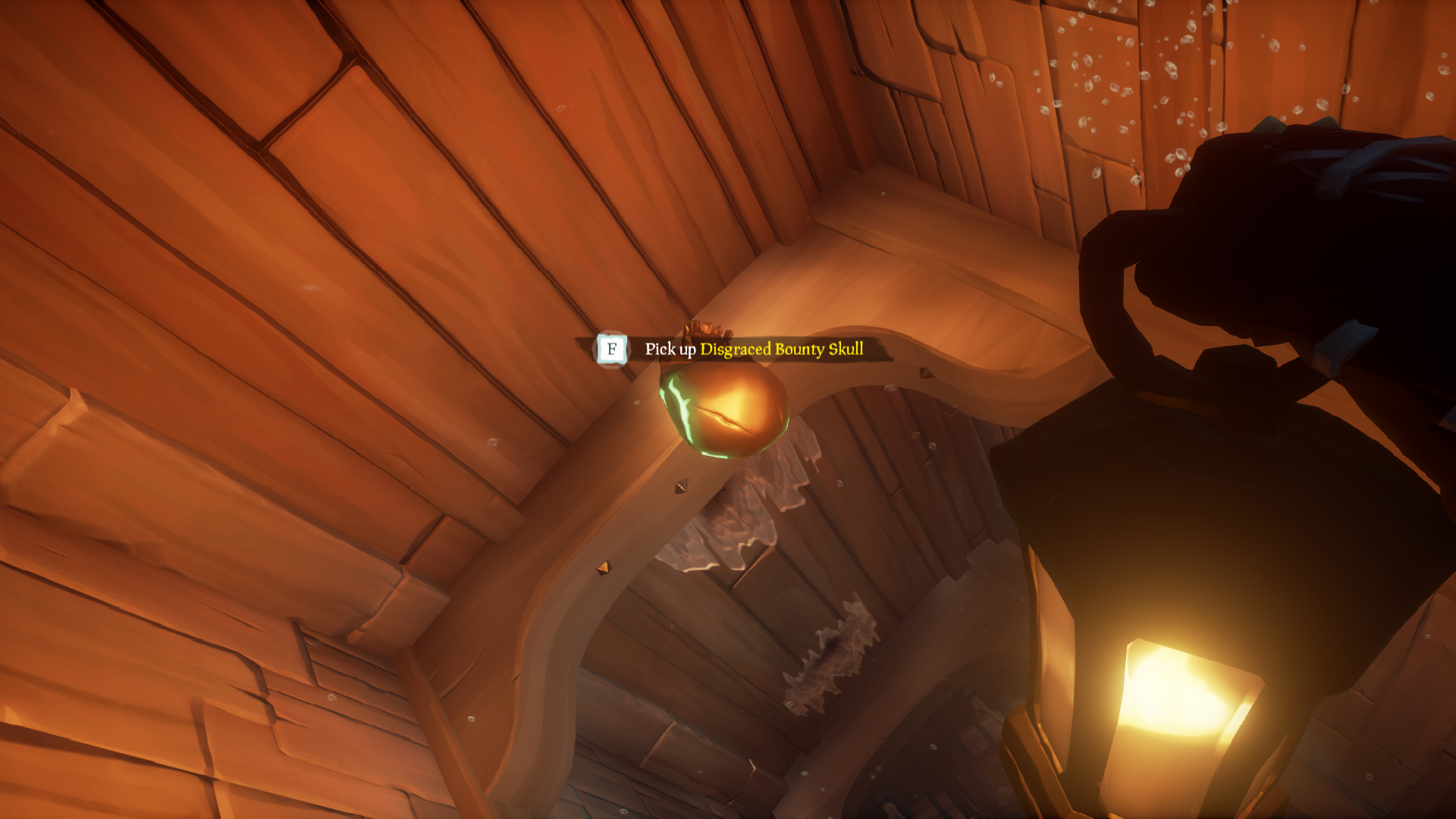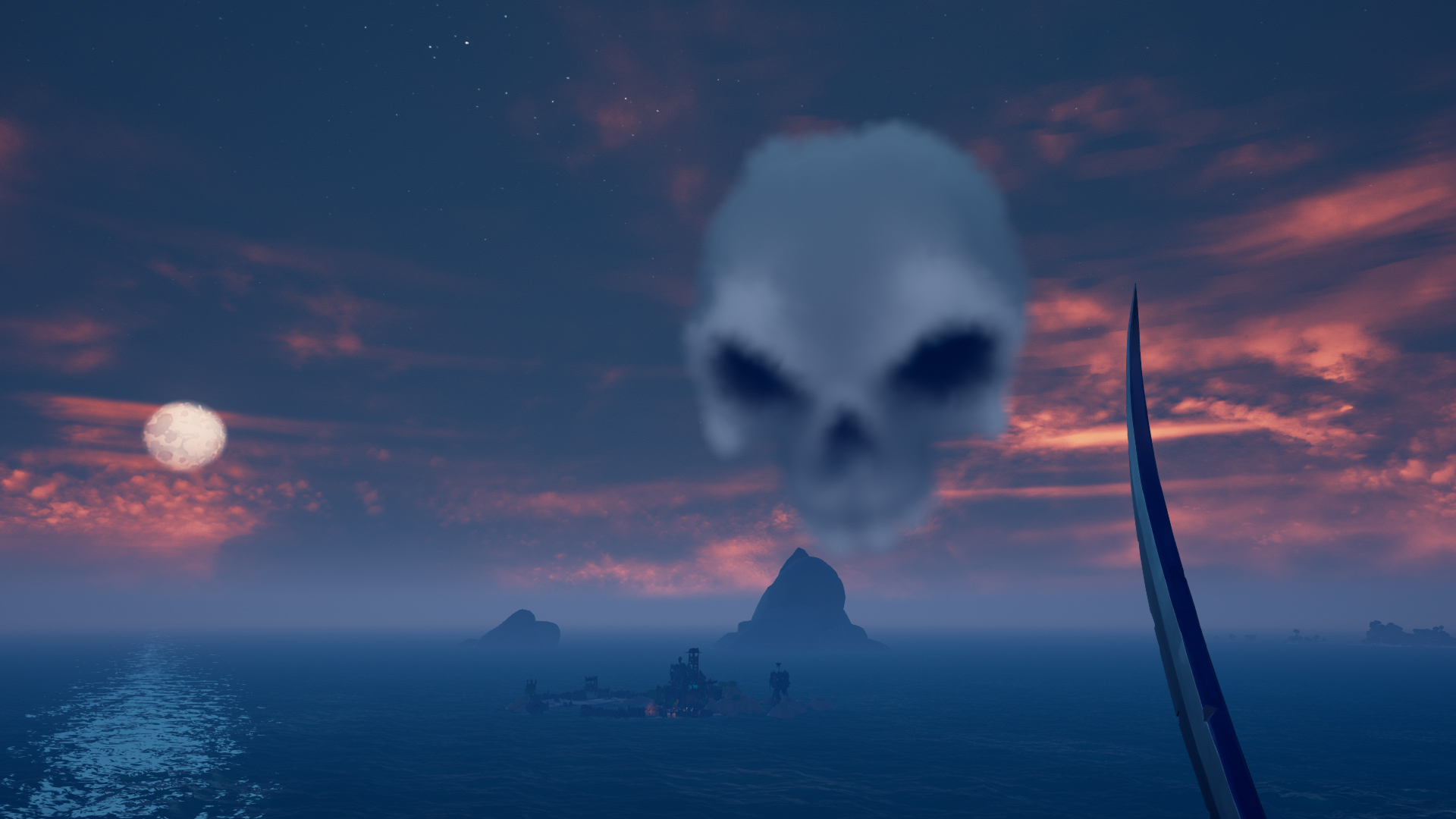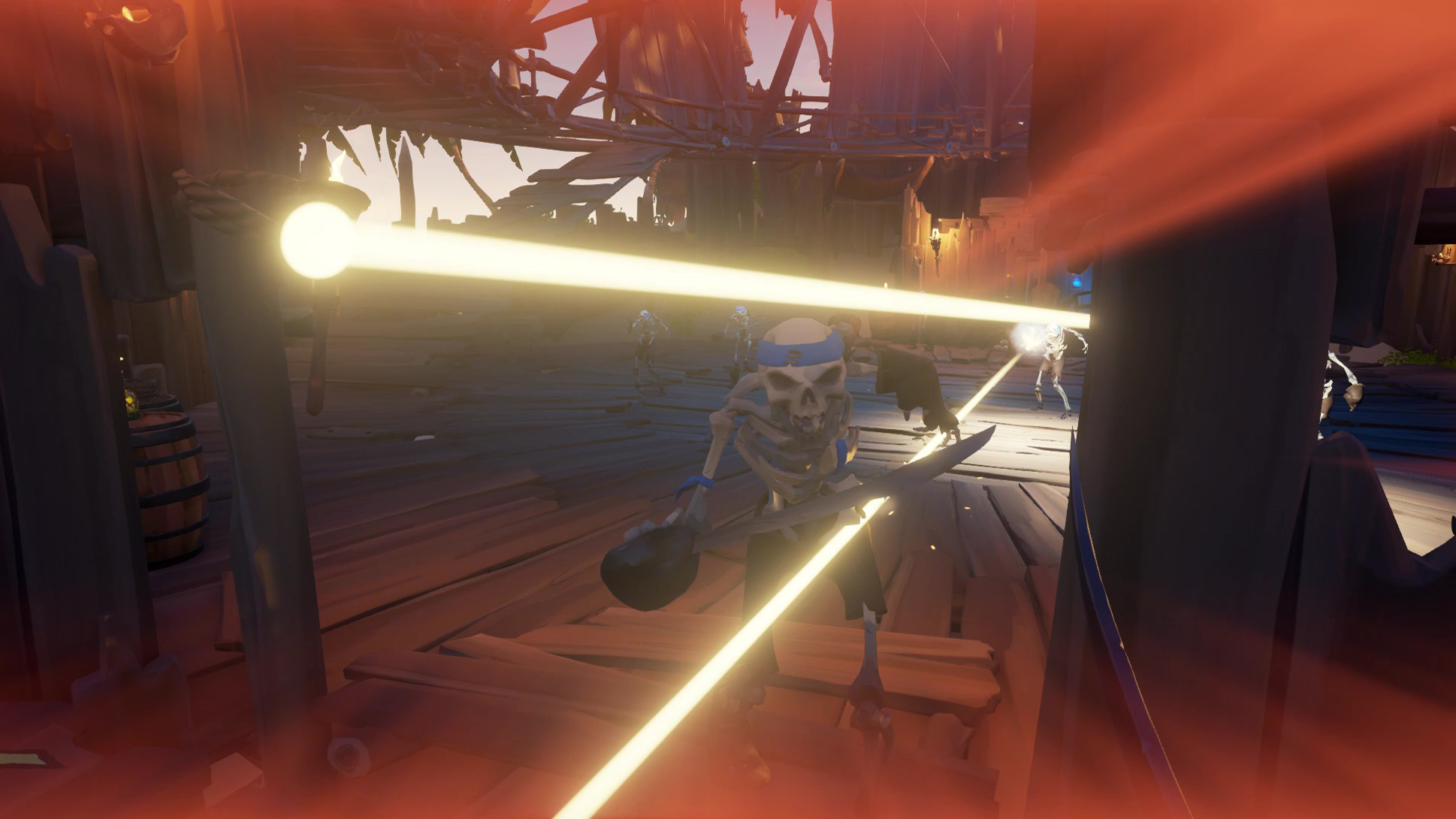Our Verdict
A superb water park for four friends to splash around in, but progression is sluggish and there are too few surprises beneath the waves.
PC Gamer's got your back
What is it? A cooperative pirate sim in which up to four players sail around an archipelago in search of treasure, while other player-controlled ships do the same.
Expect to pay: $60/£50
Developer: Rare
Publisher: Microsoft
Reviewed on: Windows 10, Core i7-6700K, 16GB RAM, GeForce GTX 980
Multiplayer? Always online. Up to four-player cooperative, in servers populated by several other player-controlled ships.
Link: Official site
Waking up in a grog-induced daze on one of Sea of Thieves' ultra-refined, painterly islands for the first time is exhilarating. You and up to three other players have a ship waiting at the dock and very little direction as to what to do. Raise the anchor and unfurl the sails and slam into a rock if you want. As the water below deck reaches your neck, you'll either drown or discover that you have to equip wooden planks to repair holes, and then your bucket to scoop up and heave the seawater back to where it came from. It feels like you can do anything.
Sea of Thieves represents a technical maturation of multiplayer action games, which are complex enough now to throw four players on a galleon in a big sea of other player-controlled ships and let them all go at it, as opposed to the strictly-structured deathmatches of multiplayer classics. By yourself, it's either slightly ponderous and peaceful, or frustrating as groups of two-to-four hound you, killing you or sinking your ship just because they can. With random crewmates who silently drop your anchor in the middle of the ocean for no reason, it's obviously a complete wash. But with friends or a good group from matchmaking—I've been matched with a couple fun crews, though plenty of assholes, too—the first five or so hours of Sea of Thieves gush with discovery and surprise and jovial stupidity.
Thrilling beginnings
There is a light structure to Sea of Thieves, built around variations on the 'fetch quest.' Go find something on an island—a chest, a chicken, the skull of a wanted skeleton boss—and turn it in at an outpost for gold. Solving these treasure or bounty hunts is usually trivial, though fun for all the little moments of inspiration that occur on your first several trips.
Your only world map is on your ship, and your only sense of direction offship comes from your compass. There's nothing in the UI to help you determine where the red X on a treasure map is in relation to yourself, or how your sails work. Learning all of Sea of Thieves' little tricks and techniques—how best to orient myself, or where to find chickens or pigs for deliveries, or how to squeak between rocks safely—made my first several sessions wonderfully fulfilling.
On a four-player galleon with three masts (the alternative being smaller one-to-two-player sloops), it takes strong coordination to pull off a flawless journey. The player behind the wheel often can't see ahead of them on account of the waves and sails. All they can see is a compass, while in the map room below another player must tell them if they're on the right course. Other tasks include adjusting the angles of the sails to catch the wind, raising and lowering them to move faster or turn more sharply, and peering through a spyglass to spot other player ships.
The line between piracy and griefing is blurry.
What nearly justifies the simplicity of the quests—they do get boring—is that cooperative effort to traverse the sea, as well as Sea of Thieves' violent nucleus: Your loot does not disappear into an invisible inventory, and doesn't stay with you if you log off. It sits wherever you put it on your ship, protected only by your ability to avoid, or fend off other players, who can snatch it (or sink you and then snatch it) and turn it in themselves for the reward. The more loot on board, the greater the nerves as you book it to an outpost to sell it.
A clever pirate can read cues to know whether or not their target has loot on board: If they're parked at an island, they're probably completing a quest (getting treasure), and if they're headed toward an outpost, they're probably planning to sell their haul. But spotting a ship is uncommon enough that, should I decide to take on the pirate's life, I go for just about any ship I can see. Disappointingly, I very rarely end up with any loot from player encounters (I think it happened once). Either they don't have any on board, or we enter into a slow-speed chase for 10 minutes before we both tire—who wants to lose their hard-earned, possibly boringly-earned, haul in a fight with someone who almost definitely has no loot of their own on board?
Keep up to date with the most important stories and the best deals, as picked by the PC Gamer team.
The best pirates may find success staking out outposts in groups of four, preying on solo and duo players—the line between piracy and griefing is blurry—though I'm not certain they'll find much more success than if they mind their own business completing quests. It takes just as long or longer to spot and attack another player vessel as it does to dig up your own treasure, and it may net you nothing or cause you to lose your own haul. The variables as they currently are don't generate rich pirating competitions, as players who choose to go into battle often do so with nothing to lose.
Cannon fire
Sea of Thieves runs admirably on my GTX 980, looking gorgeous at max settings while maintaining above 60 fps on my 2560x1080 ultrawide display. But though framerate is a non-issue, everything else is.
Rare and Microsoft have struggled to keep the servers afloat during launch week, and I've experienced several irritating bugs, such as when I was disallowed from equipping a gun for a whole session. Sea of Thieves is only available in the Microsoft Store on Windows 10, which leaves much to be desired, and the Xbox app used for partying up is a mess. Sending invites to friends from within the game hasn't worked at all for us. You also can't drop in on a friend's session in progress, as empty crew slots are automatically filled by a random player.
Now that the servers have stabilized, we haven't had much trouble getting into the game together, but the experience could be much better.
PvP ship battles are Sea of Thieves' best adventures, though, even when they're fruitless. There's a persistent urgency as you adjust the sails and slam the wheel around trying to outmaneuver your prey, sometimes fending off a boarding party with cartoony gun and sword combat. It's thrilling to peer down the barrel of a cannon and see the enemy ship come into view, to watch the shot line up as you tumble over a wave, to gaze at the arc of the cannonball overflowing with anticipation for the hit—and boom, splinters erupt, the orchestra congratulates you with a dramatic string hit, and the anticipation resets as you reload. What stupendous satisfaction it brings to see your teamwork and superior maneuvering and intuition send a hunk of iron sailing over open water into a moving target that minutes ago was a dot on the horizon.
The second most exhilarating sequences happen on the receiving end of a barrage, nearly drowning inside our hull while frantically patching it and bailing out the water. When the damage is fixed and we let the air out of our lungs, our ship is scarred with sloppy patches for the remainder of the session—or until it sinks and a new one spawns—which endears me to it as I look back and remember where each hole came from.
The rest of the time, though, Sea of Thieves doesn't quite simulate the full breadth of the sea's fury. Even in choppy waters, we have lots of time to calmly poke at the sails, realign the wheel, and check our bearings on the map. Longer voyages then are a time to chat, swap stories and tips, climb to the crow's nest to look for player ships (though with only a few ships per server as far as I can tell, not seeing any is common), and wish there were a few more pastimes aside from playing one of three songs on our accordions. The fun really depends on the company.
We also get to enjoy, at least in the too-short daytime hours, the gorgeous waves. The way light filters through water in Sea of Thieves is unlike anything I've seen in a game. When I play alone, I sometimes put on a podcast and just enjoy the ocean. It's so phenomenal that the bobbing stays with me after a long session, as if I'd been on a real boat.
After awhile, though, I start to wish something would happen. A fish jumping. A whale breaching. A school of jellies sweeping by with the current. But it doesn't—there are a few schools of fish around islands that don't react to you at all, sharks that attack you, and a bit of kelp, but that's all I've seen so far. If I could smell this virtual sea, it wouldn't smell like the ocean. It would be too sterile, not teeming but chlorinated, like the waters of the mock pirate battle at the Treasure Island hotel in Las Vegas. It's disappointing that the body of the sea—the water, the waves—is formed so well, but its guts are missing.
And while the islands of Sea of Thieves are crisp and charming—who can render palm trees that look voluminous and somehow cute better than Rare?—the same matte rocks, bushes, and debris are repeated everywhere in different arrangements. On any island I expect to find what I've found on every other island. Some chickens. Maybe a chest. A few skeletons.
The best 'off the path' discovery isn't on islands, but at sea where you can find wrecked ships bobbing vertically in the water and swim, magically-waterproof lantern in hand, deep into their holds to collect crates of sugar and tea. Shipwrecks are wonderful both for the beauty of Sea of Thieves' murky depths, and for the feeling of having found something you weren't looking for, of having been lucky that this particular wreck was well-stocked. That excitement is too rare.
Waves upon waves
The forts thoroughly succeed in their goal of creating tense alliances between multiple vessels.
I know it'll be exciting when a kraken attacks, which is one of two server events that can befall a vessel or a group of them, though I know a lot about it from other players, so it won't be a surprise. The other server-wide events are skeleton forts, which lead to Sea of Thieves' greatest treasure hoards and scariest player interactions.
Players who approach a skeleton fort—which are broadcast to the whole server by way of a giant, glowing skull cloud—have to kick skelegunners off the fort's cannons to get their ships in range, and then suffer wave after wave of skeletons before obtaining a key to a treasure horde. The forts thoroughly succeed in their goal of creating tense alliances between multiple vessels. Before approaching one, we had to fight off a galleon of jerks who didn't seem to care about the fort, but just wanted to sink us. We pecked at them from our two-player sloop like a goose protecting its nest until they finally sailed away. Later, with one of us holding down a cannon tower on the island, another galleon showed up and offered to help in exchange for half the treasure. I was skeptical, and while they weren't looking I realigned our ship so we could blast them before making a quick getaway.
Just before we defeated the final skeleton wave, I slinked away and shot a cannonball into the galleon's hull, thinking a hold full of water would distract or sink them if they turned on us. They noticed and patched the hull, but didn't seem to realize that I had done it. They had genuinely just wanted to share the treasure with us. I felt terrible, but still skeptical as one of them offered to board our ship to ensure we had an equal share. Ashamed, I yelled "nope!" over local voice chat and we hauled ass out of there with a chest and a couple expensive trinkets.
It was tense and morally fraught—just as Rare planned it to be—and so brilliant in that way, but absurdly long. Every time we thought we had proven that 'yes, we are able to kill a wave of skeletons,' another wave would come. From when we first approached the fort to when we sailed away with our haul was about two hours, and we couldn't step away for a moment of it. The gold we earned from selling our treasure hardly felt like fair compensation for that struggle. Gold can only be used to buy cosmetic items, and progression toward the endgame, represented by your reputation level with the three factions you sell your treasure to, is languid.
If you don't have any friends playing Sea of Thieves, matchmaking can be rough.
When I relax about the whole progression business and can connect with friends (the servers struggled at launch, and the Xbox app used for inviting friends is junk) Sea of Thieves pumps out goofy, cooperative fun with just its essentials: four players hopping around a ship, trying to make it go where they want it to, crashing into other players doing the same. It's a brilliant way to simply hang out, overdoing it on the grog to make yourselves useless, firing each other out of cannons, finding out what happens when you sail off the map. And the ocean is gorgeous, with sunsets so spectacular they nearly justify playing the game on their own. I've enjoyed most of my time with Sea of Thieves simply because it's beautiful and freeing, as relaxing or exciting as I want it to be.
If you don't have any friends playing Sea of Thieves, matchmaking can be rough—again, the fun depends on your company. And the structured, competitive game of hunting down treasure and stealing it from others is not a complete success. It drifts into us now and then when we spot another vessel, but quickly evaporates when they turn tail, or are revealed to have nothing but themselves on board. Goal-oriented play is like sailing into the wind, often literally while en route to an island to dig up yet another chest, or metaphorically as you hold your bladder through way too much tedious skeleton combat.
Trudging through that progression molasses is not usually painful, though, as the thrill of taking down a player ship or finding a truly good haul (made possible in part by all the boring bits) and the inherent pleasantness of sailing with a crew of people you like fills most sessions with anticipation, satisfaction, and camaraderie. It's like a team-building exercise that's actually fun.
A superb water park for four friends to splash around in, but progression is sluggish and there are too few surprises beneath the waves.

Tyler grew up in Silicon Valley during the '80s and '90s, playing games like Zork and Arkanoid on early PCs. He was later captivated by Myst, SimCity, Civilization, Command & Conquer, all the shooters they call "boomer shooters" now, and PS1 classic Bushido Blade (that's right: he had Bleem!). Tyler joined PC Gamer in 2011, and today he's focused on the site's news coverage. His hobbies include amateur boxing and adding to his 1,200-plus hours in Rocket League.
